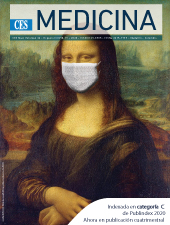Secondary skin manifestations on the use of COVID-19 protection equipment in health professional
DOI:
https://doi.org/10.21615/cesmedicina.34.COVID-19.2Keywords:
COVID-19, Skin, Cutaneous manifestations, Personal protection devices, Contact dermatitisAbstract
Since the declaration of coronavirus as a pandemic the entire world has directed its efforts to help mitigate the effects of it to the best of its ability, especially health personnel. In that attempt to help, we seek to avoid their own contact through the use of protective materials such as masks, goggles, and gloves. Although protective, this equipmment and its components can be highly damaging to the skin, causing contact dermatitis. This review addresses manifestations and reviews measures to prevent and cure them.
Downloads
References
Han Q, Lin Q, Jin S, You L. Recent insights into 2019-nCoV: a brief but comprehensive review. J Infect. 2020; 80(4):373-377
Razai MS, Doerholt K, Ladhani S, Oakeshott P. Coronavirus disease 2019 (COVID-19): A guide for UK GPS. BMJ. 2020;368(800):1–5.
Zhou F, Yu T, Du R, Fan G, Liu Y, Liu Z, et al. Clinical course and risk factors for mortality of adult inpatients with COVID-19 in Wuhan, China: a retrospective cohort study. Lancet. 2020;6736(20):1–9.
Russell B, Moss C, Rigg A, Hopkins C, Papa S, Hemelrijck M Van. Anosmia and ageusia are emerging as symptoms in patients with COVID-19 : What does the current evidence say ? ecancer. 2020;14(98).
Galvan Casas C, Catala A, Carretero Hernandez G, Rodriguez-Jimenez P, Fernandez Nieto D, Rodriguez-Villa Lario A, et al. Classification of the cutaneous manifestations of COVID-19: a rapid prospective nationwide consensus study in Spain with 375 cases. Br J Dermatol [Internet]. 2020;bjd.19163.
Elston DM. Letter from the Editor: Occupational skin disease among healthcare workers during the Coronavirus (COVID-19) epidemic. J Am Acad Dermatol. 2020;82(5):1085-1086.
Kantor J. Behavioral considerations and impact on personal protective equipment (PPE) use: Early lessons from the coronavirus (COVID-19) outbreak. J Am Acad Dermatol. 2020;82(5):1087-1088.
Bertsch RA. Avoiding upper respiratory tract infections by not touching the face. Arch Intern Med. 2015;170(9):833–4.
Skoet R, Olsen J, Mathiesen B, Iversen L, Johansen JD, Agner T. A survey of occupational hand eczema in Denmark. Contact Dermatitis. 2004;51(4):159–66.
Flyvholm MA, Bach B, Rose M, Jepsen KF. Self-reported hand eczema in a hospital population. Contact Dermatitis. 2007;57(2):110–5.
Hamnerius N, Svedman C, Bergendorff O, Björk J, Bruze M, Pontén A. Wet work exposure and hand eczema among healthcare workers - a cross-sectional study. Br J Dermatol. 2018 Feb;178(2):452-461. doi: 10.1111/bjd.15813.
Keegel T, Nixon RL. Wet work and healthcare workers: use of hand disinfectants not associated with self-reported eczema. Br J Dermatol. 2018;178(2):324–5.
Lee SW, Cheong SH, Byun JY, Choi YW, Choi HY. Occupational hand eczema among nursing staffs in Korea: Self-reported hand eczema and contact sensitization of hospital nursing staffs. J Dermatol. 2013;40(3):182–7.
Lan J, Song Z, Miao X, Li H, Li Y, Dong L, et al. Skin damage and the risk of infection among healthcare workers managing coronavirus disease-2019. J J Am Acad Dermatol . 2020 May;82(5):1215-1216. doi: 10.1016/j.jaad.2020.03.014;
Warshaw EM, Schlarbaum JP, Silverberg JI, DeKoven JG, Maibach HI, Sasseville D, et al. Safety equipment: When protection becomes a problem. Contact Dermatitis. 2019;81(2):130–2.
Al Badri FM. Surgical mask contact dermatitis and epidemiology of contact dermatitis in healthcare workers. Curr Allergy Clin Immunol. 2017;30(3):183–8.
Kosan MK, Brancaccio R, Cohen D. Occupational allergic contact dermatitis in an Obstetrics and Gynecology Resident. Am J Contact Dermat. 2003;14(4):217–8.
Kownatzki E. Hand hygiene and skin health. J Hosp Infect. 2003;55(4):239–45.
Yan Y, Chen H, Chen L, Cheng B, Diao P, Dong L, et al. Consensus of Chinese experts on protection of skin and mucous membrane barrier for healthcare workers fighting against coronavirus disease 2019. Dermatol Ther. 2020;(20).
Sinha K, Mallipeddi R, Sheth N, Al-Niaimi F. Carbon dioxide laser ablation for trichoepitheliomas: The largest reported series. J Cosmet Laser Ther. 2018;20(1):9–11.
Donovan J, Kudla I, Holness L, Skotnicki-Grant S, Nethercott JR. Skin reactions following use of N95 facial masks. Dermatitis. 2007;18(104).
Npiap. NPIAP position statements on preventing injury with N95 mask. 2020;1–5. Available at: https://cdn.ymaws.com/npiap.com/resource/resmgr/position_statements/Mask_Position_Paper_FINAL_fo.pdf
Bhoyrul B, Lecamwasam K, Wilkinson M, Latheef F, Stocks SJ, Agius R, et al. A review of non-glove personal protective equipment-related occupational dermatoses reported to EPIDERM between 1993 and 2013. Contact Dermatitis. 2019;80(4):217–21.
Foo CCI, Goon ATJ, Leow YH, Goh CL. Adverse skin reactions to personal protective equipment against severe acute respiratory syndrome - A descriptive study in Singapore. Contact Dermatitis. 2006;55(5):291–4.
Kottner J, Cuddigan J, Carville K, Balzer K, Berlowitz D, Law S, et al. Prevention and treatment of pressure ulcers / injuries : The protocol for the second update of the international Clinical Practice Guideline 2019. J Tissue Viability. 2019;28(2):51–8.
Phan LT, Maita D, Mortiz DC, Weber R, Fritzen-Pedicini C, Bleasdale SC, et al. Personal protective equipment doffing practices of healthcare workers. J Occup Environ Hyg. 2019;16(8):575–81.
Schaefer P. Acute and chronic urticaria: evaluation and treatment. Am Fam Physician. 2017;95(11):717–24.
Downloads
Published
How to Cite
Issue
Section
License
Copyright (c) 2020 CES Medicina

This work is licensed under a Creative Commons Attribution-NonCommercial-ShareAlike 4.0 International License.
Derechos de reproducción (copyright)
Cada manuscrito se acompañará de una declaración en la que se especifique que los materiales son inéditos, que no han sido publicados anteriormente en formato impreso o electrónico y que no se presentarán a ningún otro medio antes de conocer la decisión de la revista. En todo caso, cualquier publicación anterior, sea en forma impresa o electrónica, deberá darse a conocer a la redacción por escrito.
Plagios, duplicaciones totales o parciales, traduccones del original a otro idioma son de responsabilidad exclusiva de los autores el envío.
Los autores adjuntarán una declaración firmada indicando que, si el manuscrito se acepta para su publicación, los derechos de reproducción son propiedad exclusiva de la Revista CES Medicina.
Se solicita a los autores que proporcionen la información completa acerca de cualquier beca o subvención recibida de una entidad comercial u otro grupo con intereses privados, u otro organismo, para costear parcial o totalmente el trabajo en que se basa el artículo.
Los autores tienen la responsabilidad de obtener los permisos necesarios para reproducir cualquier material protegido por derechos de reproducción. El manuscrito se acompañará de la carta original que otorgue ese permiso y en ella debe especificarse con exactitud el número del cuadro o figura o el texto exacto que se citará y cómo se usará, así como la referencia bibliográfica completa.
| Article metrics | |
|---|---|
| Abstract views | |
| Galley vies | |
| PDF Views | |
| HTML views | |
| Other views | |



